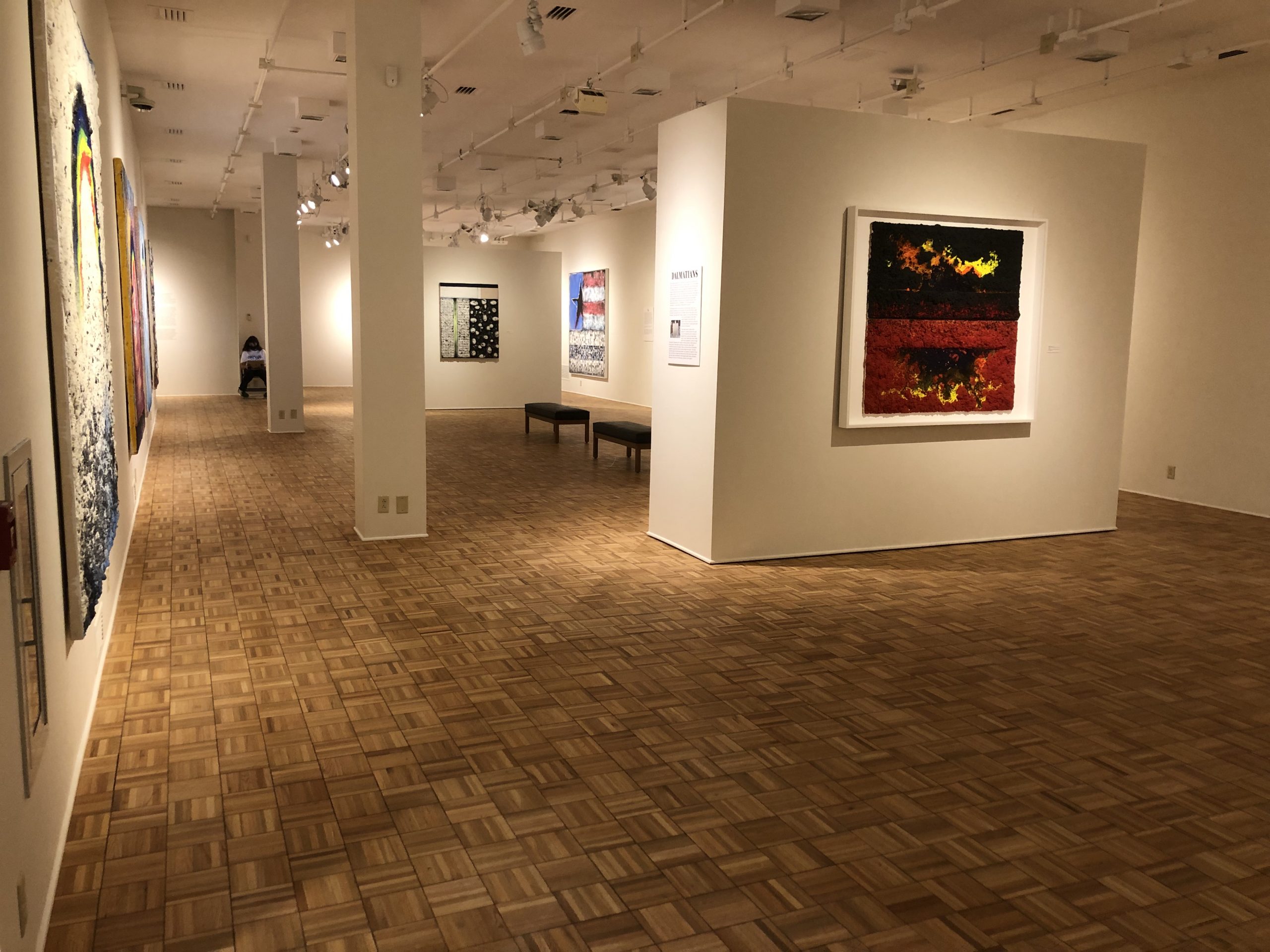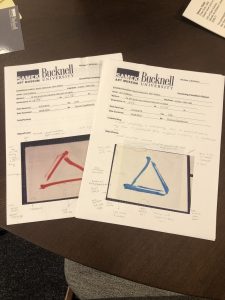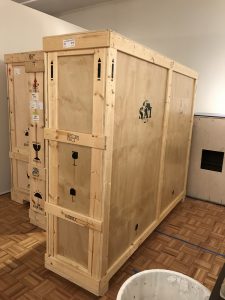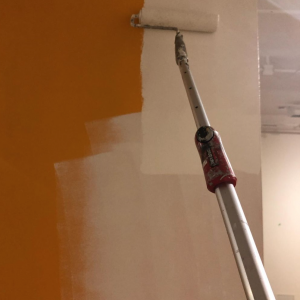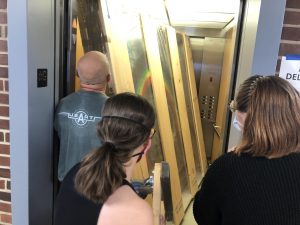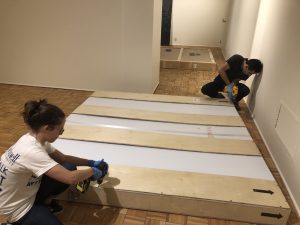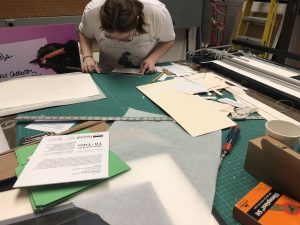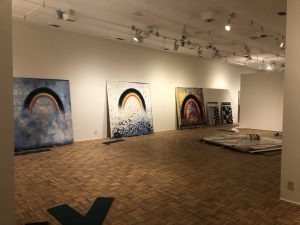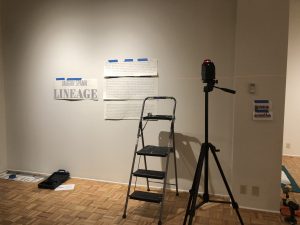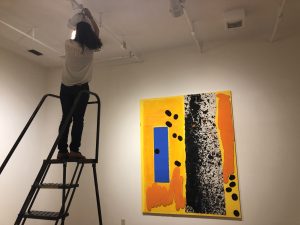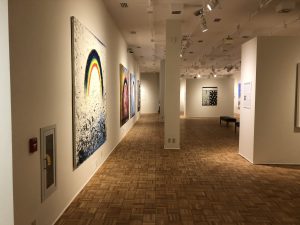If you are like many visitors to a museum, you might take for granted that after one exhibition comes down, another goes up in its place. You might notice that the gallery is closed for a week or two – and might wonder what takes so long. After all, someone just needs to take down a couple of artworks, a few nails, and then put up a few more, right?
In this post, we will give you a peek behind the scenes to show you what goes into a gallery turnover – and maybe help answer “what takes so long?!”
Step 1.
Before a new show can go up, the old one must come down. But before the work can even be removed from the wall, a condition report must be completed for each piece. This means that the Registrar must carefully assess each work of art in close detail to ensure no damage has occurred while it was on display. Any abnormalities found are compared to the condition report that was completed upon the work’s arrival. If damage is found, this must be reported to the object’s owners and a formal report filled out. Presuming all objects are in good condition (which is always the goal!) the works of art can now be taken off display.
Step 2.
De-installation of an exhibition depends on the type of work that was on display, as well as the size of the gallery and how the work was installed. For the Samek Art Museum, this process normally takes a few days. Museum staff will formulate a plan to remove works, deciding in which order to remove them, and determining what equipment – including extra staff people – might be needed for each work. Once a plan is developed, packing materials are placed nearby, ready for the artwork to be placed within. Museum staff wear nitrile gloves when handling objects, and pack it immediately after it is removed from display, which ensures the art is as safe as possible, protected from any damage that can occur when transporting art. Notably, it is when handling that most damage occurs, so it is essential that everyone communicates and follows the plan.
When packing the work, everything must be handled with the utmost care to ensure nothing is damaged. Museum staff are trained in handling techniques, and communicate for the duration of the de-installation and packing process. Works of art are packed in multiple layers, often including a wood crate or travel frame (which are as heavy as they look!). Once all the work in an exhibition has been assessed for damage, de-installed, and packed, the work is ready to be transported to its next location – this might mean it is released to an art shipper, placed in storage while awaiting shipment, or placed in collection storage (if it is owned by the Museum).
Step 3.
Now the gallery is clear of the works from the previous exhibition, but the work is far from over. Any labels must be removed, not to mention the wall text. The Samek Art Museum uses cut vinyl lettering, which must be removed letter by letter! All the hardware that was used to hang the artworks must be pulled from the walls (or ceiling!) Then, each of the resulting holes must be patched and sanded. Maintenance like this is done with extreme care, because gallery walls are patched so often they can quickly develop an uneven and distracting surface if the patching and sanding is rushed.
Next up is painting. The Museum uses a warm off-white color applied with a roller – brushes are rarely used, unless cutting in around trim or in corners, because the texture of the paint should be uniform over the whole wall. We affectionately refer to the “orange peel” texture of our wall, and using a brush in a highly visible area would disrupt the texture, and draw attention to the newly painted area. Depending on the show, we may also apply accent colors in the gallery – or have to paint over previous accent colors. Once painting is completed, we must wait at least 48 hours before artwork can move into the space to allow the paint to off gas, that is, to let the chemical smell of the paint dissipate, as those chemicals can harm artwork. While the Museum uses low or no VOC paint, it is still best practice to not only give the paint ample time to dry, but to keep art away from any unnecessary chemical exposure.
Step 4.
At this point, we have done an awful lot of work and have only just now made it to an empty gallery! While all this physical labor was being done, or even before, plenty of other tasks have been going on to prepare for the upcoming exhibition. Curators develop checklists years or months in advance of an exhibition. Then, the Registrar and Exhibition Manager sends Loan Agreements to the lenders of the pieces, which details everything from the dates of the loan to the way the lender wishes to be credited. The curator is hard at work writing the text that appears next to the tile, and any labels or text panels that will appear in the exhibition space. This text is then designed – in house – and sent to be printed in time for the exhibition opening.
Step 5.
In the months and weeks leading up to the show, great thought is already put into the physical installation process. The Samek Art Museum uses a three-dimensional imaging software to lay out the work so staff can envision what the work looks like in the gallery. When arranging shipping, we must also consider how the works are packed and how they will be brought into the Museum. The Samek Art Museum does not have access to a loading dock or a freight elevator. So, everything comes in using the same doors and elevator as visitors to the ELC. This means there is a lot of creative pre-planning to ensure everything will fit – from measuring the exterior doors, to the interior of the elevator, to accounting for the height of carts.
Step 6.
Shipping is then arranged to transport the works of art to the Museum. In some cases, custom packing must be prepared to ensure the object’s safety during transit. Depending on the exhibition, the works may be traveling from near or far. Sometimes the Museum will contract a fine art shipper to pick up and deliver the works. If the work is in a nearby city, Museum staff may also use our dedicated van to pick up the work.
So once the artwork arrives, we can get it on the wall, right?! Not too much longer?! Wrong. When the artwork is delivered it needs to acclimatize to the gallery space for 48 hours before it can be unpacked. This is when the artwork becomes accustomed to the air temperature and humidity of the new space. If you’ve ever floated a bag of fish in a fish tank to help match the water temperatures, the concept is similar! Hopefully the air in our gallery is not too different from the air the art has been exposed to previously, as the Museum keeps our space within the industry standard of 68-72 degrees and 45-55% relative humidity (thanks in large part to our talented and patient Facilities staff!).
Step 7.
The two days spent waiting for work to acclimatize is a good time to prepare some labels! Using the information from the checklist and loan agreements, labels are designed, edited, and printed. At the Samek Art Museum, we print on regular printer paper, and then mount the labels to mat board using a dry mount press. Then, the labels are cut using a mat cutter. This is all done in house, often by our much-appreciated student Museum Guides.
Step 8.
After the work has acclimated, the crates (or other packing) can be opened. This is when the show is carefully laid out, using carpet pads or foam blocks to raise the artwork off the floor and provide cushion. It is at this point that any final layout changes are made – sometimes the work looks very different in person than it did in the imaging software, so art might be moved to a different location, or spacing may be changed. Once the layout is finalized, an installation plan is developed. Museum staff determine which works will be hung in what order, and checks that all tools and hardware are on hand. Depending on the type of work being hung, hardware can vary from an art-hanging hook to a wall cleat that distributes the weight more evenly across the wall. This planning stage is important, as it is when you determine what type of hardware is best used for each work, preventing any accidents like heavy paintings falling off of the wall.
Step 9.
But, before any screws or nails can go into the wall, there is another very important step: math. Many people do not realize just how much math goes into an exhibition installation. For two-dimensional, wall-hung artworks, several equations are done to make sure each work is hung at the same eye level, and that spacing between them is equal. At the Samek Art Museum, we hang work so that the center of the piece is 60 inches from the floor. To do this, we must measure the height of the work, as well as the positioning of the hanging hardware. The wall is marked before anything is hammered or drilled, as any extra holes would need to be patched and painted – which given the presence of art in the space, is now best avoided. Once the wall is marked and double-checked, the work is carefully lifted into place by Museum staff (wearing gloves, of course!)
After every work is installed, an incoming condition report is completed for each, once again studying the work for any pre-existing damage or other condition. This can include scratches to the frame, flakes of missing paint, rippling paper, or any number of hundreds of conditions our staff are trained to look for. These reports are filed, and will be used for comparison when the work is taken down.
Step 10.
Even though the work is now safely on display, the exhibition is not yet ready to open. The labels, text panels, and title vinyl that was prepared earlier is now ready to hang. Labels are hung at a consistent height – a laser level is a great tool! Labels are adhered to the wall with painters tape or other easily-removed adhesive. The title vinyl is applied differently. Each letter is like a sticker with adhesive backing. The template is centered and taped in the appropriate position and checked with a level. Then the backing is carefully removed and it is smoothed onto the wall.
Step 11.
The works of art must be properly lit – which means it is time for staff to take out the ladder or the rolling staircase! Museum lighting is an art unto itself – depending on the temperature of the
bulb, the angle of the light, the number of lights, and the distance from which the light is thrown, the artwork can look different. Good museum lighting lets an artwork look its best, minimizes distracting shadows, but doesn’t over-light the work of art either. It is done one artwork at a time, and often requires some adjustments as you move through the gallery. Works of art aren’t the only thing that need light – labels, text panels, and the title wall also need good, even lighting so that they are legible.
Step 12.
At this point, the show is almost ready! Now is when the space is cleaned. Any tools that are still out are put away, the floor is swept, chairs and benches are placed in their appropriate positions, and we ready the space for visitors! The show is up, but our work is not done – we will spend the duration of the exhibition providing educational tours, welcoming class visits, and hosting events. Then, when the show closes, we will begin the process anew for the next exhibition!

